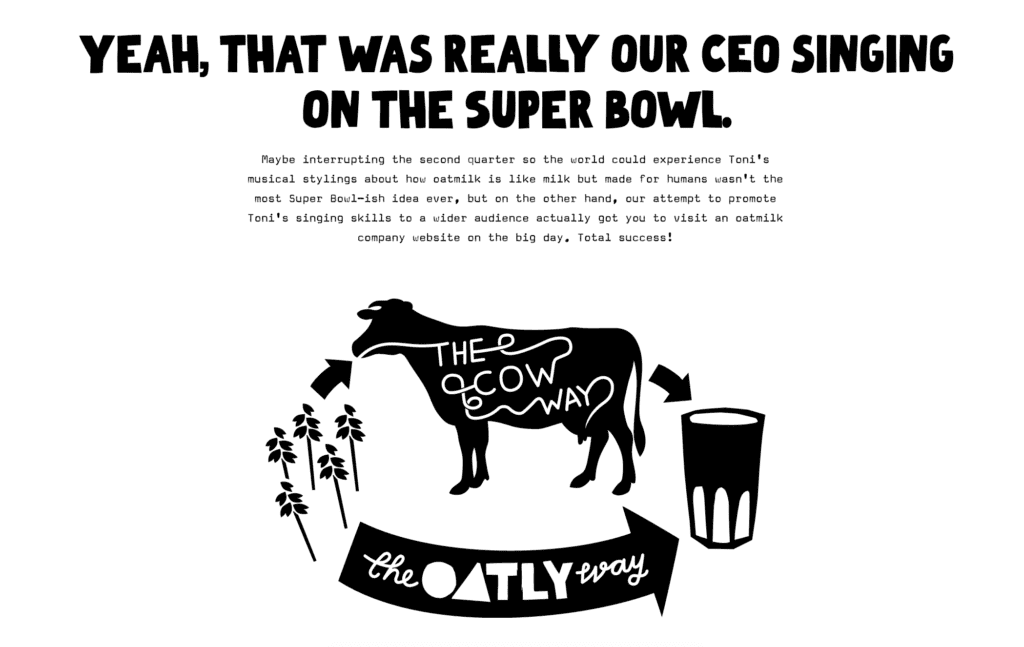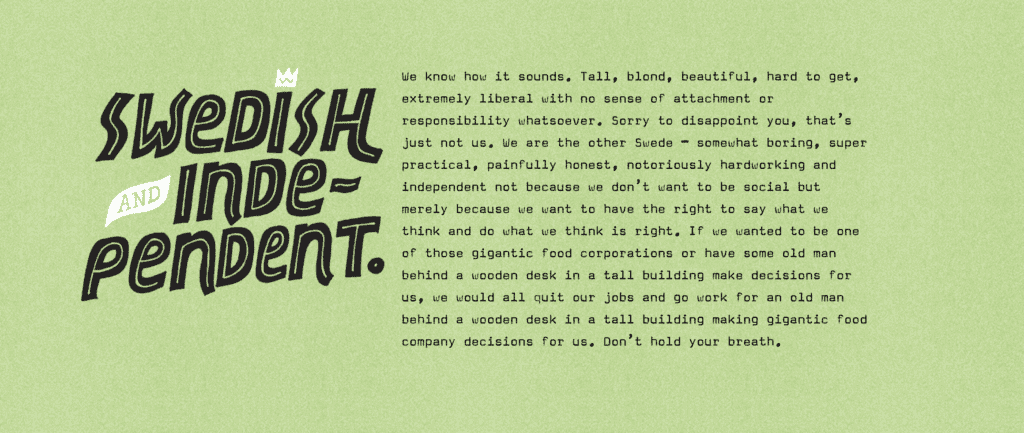Why Personalization and Unique Attributes Stick With Customers
Wow, Wow, No Cow.
Is the song from the Oatly Super Bowl commercial still stuck in your head? Yeah, it’s stuck in ours too.
Oatly CEO Toni Petersson is, to say the least, a brave soul to blast that singing voice out to the entire nation. It was a weird commercial. We still feel weird thinking about it.
And the question is: What the heck?
“No choreography, music licensing, famous actors — possibly even no director. This year’s jankiest ad came from Oatly, a company that is very good at making oat milk and very bad at making commercials.”— The Washington Post |
Yet, with boldness comes interest—even if everyone says it was the “worst Super Bowl commercial ever.” But can it be the worst Super Bowl commercial ever if we’re still talking about it?

That all depends on how you define success. And in marketing, success usually equates to money.
This week, it was reported that Oatly is eyeing a $10 billion (yes, with a b) IPO today, which is a lot of dollars considering that in July, the company was reportedly worth only $2 billion.
So, that sounds like success to us.
Why The Oatly Super Bowl Commercial Worked
Think back to the commercials that you’ve seen recently … what do they have in common?
More likely than not, they triggered some sort of emotion, like humor or sentiment. These are common emotions that stick with you for extended periods.
That’s because, as humans, we’re wired to remember things that impact us. Makes sense, right?
“Oatly commercial is the only one that accurately illustrates our collective mental state.”— Cherie Hu (@cheriehu42) |
Everywhere we turn, we’re inundated by marketing materials; from the podcasts we listen to on the way to work to the Instagram pages we follow, everything is trying to sell us something. And we’ve learned how to tune out that message.
But there’s something that just breaks through that marketing wall we’ve put up: Uniqueness. And companies can decide where they fall on that spectrum of uniqueness, like if it’s humor that works for them or tugging at someone’s heartstrings, but the fact of the matter is: You have to be different to stand out.
It doesn’t sound so complicated (or even that novel), right? So why are we surprised when a national brand embraces that on such a large scale?
Your Brand is More Than A Product
Finding success as a business depends on how well you can articulate your differences. You have to be able to be heard above all the rest of the marketing noise that exists.
Each business has its own unique identity and style, and it’s the job of marketers to dissect that identity and use it to develop a strategy that sells the brand. That Oatly Super Bowl commercial just decided to take a pretty … unique path.
“Haven’t had real milk in months, but that Oatly commercial has me strongly reconsidering.”— Derek Johnson, The Atlantic staff writer |
But before you and your marketing team can articulate your differences, you have to first understand what makes you stand out from the competition. Yet all too often, when we ask our clients what makes them unique, we hear answers like:
- Our product is [insert exciting-yet-meaningless buzzword here].
Or
- We’re the industry leader in our industry.
*Cue internal groan*
As marketers, we understand that to find success, we need to dive into what makes a company different. Those things listed above? They’re not differences—it’s useless jargon that we have to sift through to get to the message’s real crux.
Here’s how we do it.
How to Find Your Unique Brand Identity (And Own It As Shamelessly as Oatly)
Establish your value proposition
What does your business do? Why does it do it?
When you take the time to really answer these questions, you might find that your brand identity is right in front of you—or maybe, you won’t. Often, answering these questions can take a lot of time and energy, and it’s usually the seventh and eighth iteration of the answer that works.
The purpose of a value proposition is to figure out what you want to say before you figure out how to say it. And we don’t mean the literal marketing message; we mean the high-level, fluffy stuff like mission, vision, and purpose. Here’s an example of how we figured that out for one client.
Our goal in this step is to dive deeper into the tangible benefits a product or service provides to its customers. Sure, it could be a milk alternative that tastes good (like Oatly), but many other companies out there are doing that (80 products in six categories, to be exact), so that might not be the best avenue for distinguishing itself in the marketplace.
That’s where finding opportunities to shine comes into play.
Find positioning opportunities
Now that you know who you are, you need to figure out how to tailor that message to resonate with your audience. We call it positioning. It involves tapping into the emotions that your customers feel when they choose your brand.
It’s hard to be unique if you don’t know what’s already out there. So, you must research the industry you’re in, both on a global level and a local one (if that applies to your business strategy), to see what potential consumers are looking for from a brand.
You want to look for things like:
- What your customers’ interests are and how they talk about them
- Who your main competitors are and how they talk about themselves
- Strengths and weaknesses of your competitors
Get creative in the way you answer these questions. Look at Subreddits on the topic or interview people in the target market. Analyze the search results in your target category or buy a competitor’s product for yourself.
Using Oatly’s industry as an example, we can see that alternative milk is usually purchased by those a little bit more on the “crunchy” side, ones who shop at Whole Foods and recycle. These people are more likely to want to buy local or from someone they trust, not a massive corporation.
So when we compare that to the industry itself, which is dominated by a massive corporation (H P Hood Inc, with brands like Silk Diamond, Planet Oat, and Lactaid under its umbrella), Oatly saw an opportunity to be the Wizard of Oz, or the voice behind the curtain.
The company decided to call out the fact that most healthy alternative milk brands are feeding into corporate America, using this differentiator as a critical branding element:

And it worked. In the 52 weeks ending June 12, 2020, H P Hood Inc brands generated $50+ million worth of refrigerated milk substitute sales while Oatly was a close second at $30 million.
Create consistent branding
Now that you know what you want to say (value propositioning) and how you want to say it (positioning), it’s time to create a brand.
One way to do this might be a brand book, where you outline rules for the brand like right and wrong words or what types of images match your brand style. We prefer this method because, as marketers, most of us are visual learners, so putting rules into play that can easily be accessed and referred to makes it easier for us to do our jobs efficiently and effectively.
During this phase, you want to dive deep into how you want a customer to feel when they see your brand. Ask yourself the question of what this brand would look like if it were a person?
When you watch the Oatly Super Bowl commercial, their CEO completely embodies that: Casual and comfortable. Your brand might be more modern and trendy. Maybe it’s traditional and professional. Understanding what types of emotions or feelings define your brand can help you narrow down your branding in a way that can travel across multiple facets, including:
- Logo
- Tone and voice
- Graphic use
- Mission, vision, and purpose
- Packaging
- Social media presence
And so much more. You could even take that one step farther into the five senses (and no, we don’t mean scratch and sniff stickers). Some companies utilize sensory branding to set themselves apart, like that distinct Abercrombie and Fitch scent or the identifiable lock sound that an Apple phone makes.
Whatever avenue you decide to take, make sure it’s unique in the industry and personalized to who your brand is.

Live your brand every day
But just hiring a good marketing team to make you stand out in the industry isn’t enough; you’re going to have to put it into play every single day as a business. That means every decision you make should be checked against your branding.
Your brand identity and strategy will help guide your marketing efforts, helping you stay focused on your organization’s mission and vision. That way, when a “good idea” comes up in a pitch meeting, you have clear and defined rules that allow you to decide if that strategy is right for you.
For example, there’s a massive market for almond milk right now, so it could make sense for Oatly to dive into this opportunity and capitalize on their name recognition. But does it align with their sustainability values and maximize their operations in a way that makes the lowest impact? No.
Just because it’s a good marketing idea doesn’t mean it makes sense for your business. By living and breathing your brand every day, customers will come to see the authenticity in your marketing and respect you more for it.
Does all of this sound ridiculously complicated to you? Maybe it should. Branding isn’t for the faint of heart, but it is imperative in your business’s overall success. Let us help. Contact us today for a free strategy session to see how we can help your brand now and in the future.



